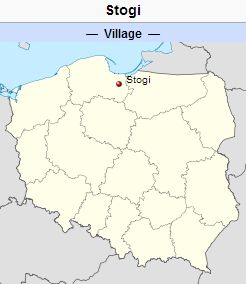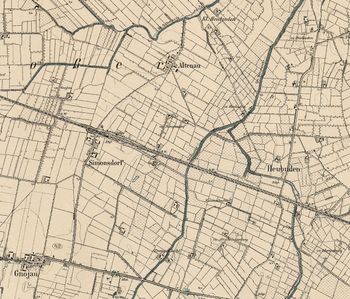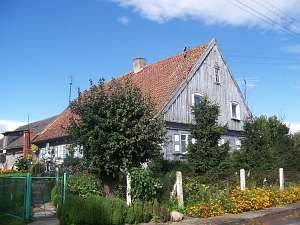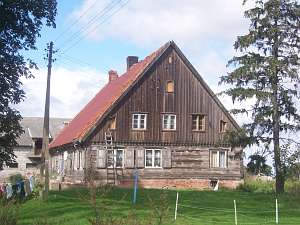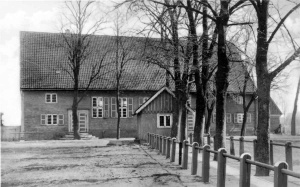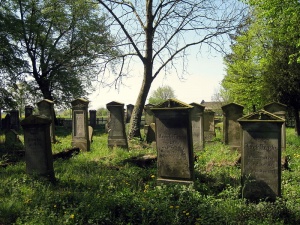Heubuden (Pomeranian Voivodeship, Poland)
Heubuden (once known as Hejbudy and now known as Stogi; coordinates: 54.063523, 18.971317 [54° 3′ 49″ N 18° 58′ 17″ E]; population in 1904, 413, in 1929, 395; in 2012, 430) is located approximately 7 kilometres (4 miles) north-west of Malbork (Marienburg) and 40 km. (25 mi.) south-east of the regional capital Gdańsk (Danzig). In 2012 it was a village in the administrative district of Gmina Malbork, within Malbork County, Pomeranian Voivodeship.
Heubuden was a village in the former Free City of Danzig, three miles northwest of Marienburg, the seat of the former Mennonite congregation Heubuden-Marienburg, which was the largest rural congregation of East Germany. In 1929, the membership was 1,092 besides 358 children under 15. The members were mostly farmers and owned a total of over 25,000 acres. Most of them lived in the southern part of the Gross-Werder, a smaller part in Marienburg and east of the Nogat in former West Prussia, and several at Dirschau (Tczew) west of the Vistula on Polish territory. The ancestors were almost exclusively Dutch immigrants. In 1565 there were in the area of Heubuden some Mennonite renters who were making their payments to the Koczelitzki. Until the middle of the 17th century the congregation apparently had no preacher and was served by the ministers of other congregations, especially Danzig. In 1662 Herrenhagen was settled. Mennonite settlers with hereditary leases settled on the former estates of the Teutonic Knights such as Leske, Diebau, Kaminke, Kalthof, Klein-Montau, Sandhof, Laase, and Schroop; similarly on lands owned by Marienburg in Dammfelde and Stadtfelde; they also purchased pieces of land in the freikölmisch villages or bought new estates on lands farther removed from the villages. So there were at a very early time Mennonites in Koczelitzki, Altenau, Klein-Lesewitz, Halbstadt, Tralau, Lichtenau, Simonsdorf, Gnojau, Kunzendorf, Altmünsterberg, Mielenz, Schönau, and Wernersdorf.
The manager of the estate belonging to the Marienburg castle about 1584 settled a number of immigrants from Brabant and Schottland on the estate lands. Among them there were some Mennonites. Upon the complaints of the citizens and the command of Sigismund III, these were denied all civil rights; but the manager in spite of manifold objections from the citizens settled craftsmen and tradesmen here again and again. Especially after 1672 the lowlands around the castle were settled by foreign, particularly Mennonite, tavernkeepers, Höcker, and craftsmen. In Kalthof the manager rented out lands owned by the city and permitted Mennonite potters and merchants to set up business there; thus in 1767 a Mennonite established a vinegar brewery. In the Werder gristmills were built, the oldest ones in 1747 at Koczelitzki and Leske. In 1748 the city of Marienburg leased the castle lowlands, and the Mennonites were now given the rights of citizenship.
Frequently the delegates at the various Landtags protested against toleration of the Mennonites (Mannhardt). As late as 1700 a resolution was drawn up forbidding Mennonite meetings in the Vorschloss (a street in Marienburg) and in the castle warehouse.
The Mennonite worship services were not public. In the 17th century they likely sang little at their meetings; but they had hymnbooks such as van Mander’s Gulden Harpe. In 1724 and 1752 Dutch hymnbooks were printed at Amsterdam for the Prussian congregations. After the beginning of the 18th century there was singing at their meetings, the singing conducted by a chorister. For their meetings they chose "either in the wintertime large rooms on the farms or in the summer good barns and large cow stables which were carefully cleaned and decorated with greenery. The preacher, when he preaches, sits on a high-backed chair and the hearers sit about him" (Hartwich). "The preacher delivered his long address of two hours in the Dutch language seated and without an outline before him." It was the custom that each sermon was delivered on three Sundays. Already in 1671 Georg Hansen wrote that the youth could read German better than Dutch; nevertheless the Dutch language remained in use until 1750-1760. In those years a beginning was made in preaching in German from notes and in a standing position. In 1767 German hymnbooks were introduced; nevertheless soon after the beginning of the 18th century Lobwasser’s Deutsche Psalmen were used, which were incorporated into the first editions of the German Mennonite hymnal.
In the wars between Sweden and Poland the Mennonites "suffered severely under many war disturbances and extortion of money by Swedes, Russian, Saxons, and Poles, but always preserved their freedom of conscience and religion as far as was permitted in Catholic countries" (Donner). On 18 July 1626 the Marienburg castle surrendered to the Swedes. In 1656 Marienburg was besieged by the Swedes, in 1659 by the Poles. In 1698 began the quartering of soldiers in the third Swedish-Polish War, which continued in this region until 1715. The people of Heubuden had to deliver horses, grain, and other produce, as well as money payments. Marienburg and the Werder were occupied and plundered in turn by Swedish, Polish, Russian, and Saxon troops. In 1765 the people of Heubuden protested against oppressive Russian quartering which was illegally imposed on them.
Breaks in the dikes of the Vistula and Nogat caused great floods—1622 and 1652 at Wernersdorf, 1717 at Kalthof, 1786 at Gross-Montau, 1816 at Wernersdorf, 1839 at Kalthof, 1845 at Schönau, and the last and greatest on 28 March 1855 at Gross-Montau. In 1620 a plague raged in Marienburg, in 1624 in the Klein-Werder, and in 1710 in the Gross-Werder.
In 1638 the Jesuits had acquired the clerical lands in Koczelitzki. On 12 December 1701 the Jesuit priest registered a complaint to the royal judge in Marienburg that the people living at Heubuden were refusing to pay the tithe, asserting that they had never paid it and besides paid conscientiously the fees for baptism, marriage, and burial, and in every respect submitted to the community law. On 7 July 1755 there was again a complaint, since according the rescript of 2 August, on 3 April 1699, the Mennonites were to pay the pastoral fees for the liberty to baptize, marry, and bury, and especially they were to present within a week from the birth of a child the permission for baptism. They were ordered to pay the fees of one florin for permission to baptize and for the right to marry and bury, as had been customary from olden times. "But with regard to the forbidden burial of unbaptized children among the baptized in the Mennonite cemetery, a special place beside the regular one where baptized Mennonites are buried shall be assigned to them and shall be fenced off by a fence." According to Hartwich, they buried their dead quietly in the Catholic cemeteries about 1700; they had to pay a high price for the lots to the Catholic priest. Not until 1775 were they released from payment of fees to the Catholic priests. The cemetery beside the church at Heubuden is mentioned for the first time in 1755. It was plotted and kept up by Mennonite owners of the land in the surrounding villages. In 1905 the congregation took over the burial place.
Until 1728 the congregation was served by the elders of Danzig and the Werder; by the Danzig elder demonstrably since 1694, while Elder Dirk Siemens of the Werder served the Elbing congregation. In 1728 Jacob Dyck was chosen as the first elder in Heubuden and confirmed in the office by Isaak de Veer of Danzig. He died in 1748. As early as 1741 upon the wish of the 81-year-old Elder Dyck, another elder, Gerhard von Bergen, had been chosen. In addition to the two elders there were now six preachers and one or two deacons in service. After the death of Elder von Bergen in 1771, Cornelius Regier was chosen as elder. He was succeeded in 1795 by Peter Braun. Preachers to be chosen were first called as deacons. From the ranks of the deacons the preachers were then chosen in the second stage of the election, and from among the preachers the elder was chosen. The right to vote was possessed by all male members above 21. According to the constitution adopted when the congregation became incorporated, preachers were to be chosen from among the membership.
By 1744 the congregation was so large "that they had preaching at two places on Sunday." For the members living further removed from Heubuden, services were held in the homes of members in Marienburg (Sandhof), Wernersdorf, Klein Lichtenau and Lesewitz in rotation every fourth Sunday and on the first of the holiday days. In 1774 when 14 Mennonite families had been settled by King Frederick II in Czattkau near Dirschau, these families joined the Heubuden congregation in 1778. Among them, as in the other outside locations, services were regularly held, so that there were now services every Sunday at two places, every fourth Sunday at three places, and on the first holiday day at six places. After 1700 the Flemish Mennonites living among the Frisians in the vicinity of Stuhm and Marienwerder became a subsidiary congregation, Jerczewo, united with the Heubuden congregation (see Pastwa). This congregation had its own preachers and deacons but was served by the elder of the Heubuden congregation and had a common treasury with Heubuden. In 1854, the congregation built a church in Pastwa. This sub-congregation with 81 members and over 20 children united with the Frisian congregation of Tragheimerweide in 1899.
A Privilegium granted by the Bishop of Culm on 17 June 1768 gave the Heubuden congregation and three other Mennonite congregations the right to build a church of wood 40 ells long, 22 ells wide, with walls 7 ells high, with a thatched roof and a chimney towering over the roof. The building was begun on 19 July 1768, but after considerable progress had already been made, it was forbidden by the bishop and after renewed efforts and expenses released again on 2 November (see Fürstenwerder). When the work was halted, members of the congregation took individual parts of the church home and worked on them, so that rapid progress was made when the building was renewed and services were held in it at Christmas time. In 1853 the church was lengthened 14 feet and jacked up two feet and a masonry foundation laid. In its final stage it seated an audience of 800.
The congregation owned two houses, each containing four apartments known as "hospitals" for poor members. They are listed for the first time in 1773 in the Prussian land records. An area of 6 ½ acres of cultivated land belonged to the "hospitals."
The Heubuden congregation, like those of Danzig, Gross-Werder, and Elbing, belonged to the Old Flemish branch (Danzig Old Flemish). In the 18th century or perhaps at the end of the 17th, these congregations formed a Flemish conference with seven congregations in Holland, namely, Amsterdam, Haarlem, Rotterdam, Blokzijl, Zuidveen, Giethoorn Northside, and Oldemarkt. The Dutch language was used for church services in Heubuden until about 1770. The oldest confession of faith, as far as is known, was that of Georg Hansen, published in 1667 in the Dutch language. In 1730 it was sign by the elders and preachers of the Danzig, Heubuden, Gross-Werder, and Elbing congregations, then sent to the Dutch congregations in the conference, where it was copied and returned. They declared, "Although we have been parted for more than 100 years, nevertheless our confession has remained unchanged." This confession was printed in German in 1768 and used in the congregation until 1861. Beginning in 1862, the congregation used the confession of 20 articles worked out by Gerhard Wiebe of Elbing-Ellerwald in 1792. On 14 February 1897 the congregation decided to adopt the confession worked out together by the Flemish and Frisian congregations.
For the instruction of baptismal candidates the congregation used the (Elbing) catechism compiled in 1778 by the elders Heinrich Donner of Orlofferfelde and Gerhard Wiebe of Elbing-Ellerwald, in 1929 in its ninth almost unchanged edition, in 1935 in a 10th (shortened) edition, there were, however, as early as 1700 instruction books in the form of questions and answers.
In the union of the Flemish congregations of 1730 one of the stipulations was that no one should be accepted in the brotherhood without baptism unless he had already been baptized in one of these united congregations. Members of a Frisian congregation were therefore rebaptized before being received into the Heubuden congregation. This custom was maintained until 1770, when the person to be received was admitted by simply answering some questions before the congregation if he had already been baptized. After 1819, an admission into the congregation was simply announced to the congregation. If anyone from another creed under the Polish government wished to unite with the Heubuden congregation, he had to travel to the Netherlands, be baptized there, and return as a Mennonite. After 1744 the latter could also be baptized in Königsberg, since there was a Mennonite elder there. Under the Prussian government the Mennonites were free to take in members of other confessions with the government’s permission. This was later made almost impossible by the edict of 30 July 1789, according to which a person transferring from the state church no longer could retain all the privileges of citizenship (kantonfrei); however, in 1824 and 1828 concessions including all the rights of the kantonfrei Mennonites were still made. In 1910 in a meeting of the congregation, it was decided to admit persons of other Christian churches at their request without baptism.
Marriage with members of other churches was not permitted, and until 1775 marriage with Frisian Mennonites only when the latter joined the congregation. In the time of the strictest church discipline, a broken engagement was dealt with so severely "that not only was marriage forbidden to both, but the one breaking the engagement was excommunicated and not received again until the other died." A widower was also not permitted to marry the sister of his wife; if it happened, he was excommunicated as long as the marriage continued. This rule was dropped in 1826. Remarriage of divorced persons was not permitted. In the 1920s, however, several instances occurred in which the innocent member remarried.
Feetwashing was practiced until about 1750, and especially "when an elder or teacher was called or sent into another congregation by God, so that his feet are washed when he arrived; also when a member of one congregation enters another congregation to remain."
Church discipline was carefully administered. In several meetings at the end of the 18th century and the beginning of the 19th, it was decided "to see to it that no member betray the smallest article of our faith unpunished." In cases of lesser disobedience, the one concerned had to appear before the church officers, in more serious instances, before the brotherhood; if there was no improvement, or if there were grievous offences, excommunication followed. A list of excommunicated members kept by the elder in 1805-1899 still existed in 1929. After that, excommunication was not practiced.
"It was not customary for us to keep a systematic church book, and not necessary because the Polish government never demanded birth or death lists or birth, marriage, or death certificates. Each elder listed only as much as he needed for his own system." In 1775 the congregations were ordered by the Marienburg government "to draw up a list of those who were born in our congregation, had died, were married, or had attended communion." The church possessed a list of those baptized since 1771, church books on births, marriages, and deaths since 1 December 1771, and a list of participants in communion since 1851. In the summer of 1799 they received instructions from the government to report all births, marriages, and deaths to the pastor of the state church. This regulation remained in effect until the introduction of the civil register in 1874.
"Since all of Polish Prussia was occupied by the King of Prussia on 3 December 1772, and a day of homage was to be observed in Marienburg on 27 December following, Peter Regier called the West Prussian congregations to a meeting at Tralauerfeld, to which the Flemish as well as the Frisian teachers came." Until then the officers of the Frisian and Flemish congregations had usually held separate meetings. Only at special occasions, as, for example, the granting of the Privilegia of the Polish kings and bishops, did they appear together, because this was always very expensive. From this time on there were regular meetings for both areas, often several in the year. Because of the central location of the Heubuden Church most of the meetings were held in its territory. Of the two meetings in 1802 and the eight in 1813, six were held in the Heubuden Church.
On 22 August 1774 the first taxes were collected by Preacher Hans Klaassen in Heubuden from all East and West Prussian congregations. Of the total of 13,495 souls, 1,831 were from Heubuden without Jerczewo. 503 of the 2,170 parcels (Hufen) of land were from Heubuden, and of the total sum of 30,624 guilders, 5,343 were from Heubuden. In the village of Heubuden, 67 Mennonite homes occupied 63 2/3 parcels of land.
The 1776 Prussian census lists 47 Mennonite families in Heubuden with the following surnames: Bickert, Born, Brun, Claasen, Conrad, Dick, Dickmann, Dircksen, Ens, Epp, Fast, Friesen, Giesbrecht, Gunter, Hamm, Harder, Kosdorff, Loewen, Mattis, Neufeldt, Pauls, Peters, Regehr, Toews, Van Bergen, Warckentin, and Wulff. In 1820 Heubuden had 301 inhabitants, of which 202 were Mennonite. In the 2nd half of the 19th century, the village had 137 włókas (2,460 hectares) of land, 45 houses, 154 Catholics and Lutherans, and 176 Mennonites.
In 1788, 17 families left the congregation with the first immigrants to Russia. No record was kept of further emigrations. According to the treasurer's books, there were frequent contributions for immigrants to Russia, especially in 1803, 1819, 1858, and 1869. On 14 March 1794, Elder Cornelius Regier and the preacher (Lehrer) Cornelius Warkentin traveled to South Russia to organize and establish the newly formed congregations there. Regier died on 30 May in South Russia. In 1795 the Heubuden congregation chose Peter Braun as elder. After his death on 11 June 1803, Abraham Regier was chosen as elder on 6 January 1804. After he had faithfully served the congregation for over 47 years, he died on 8 August 1851. On 20 May 1852, Gerhard Penner was chosen as elder, serving until his immigration to America on 30 May 1877. Wilhelm Fast served from 28 October 1877 to his death on 6 September 1903. He was followed by Bernhard Klaassen from 31 January 1904 to 8 March 1927. Heinrich Dyck served 1924-1935, and Bruno Ewert 1935-1945. Gustav Reimer served as deacon 1919-1945.
In 1807 began for the congregation the difficult times of the French occupation. Heubuden village had to raise 22,249 florins from 6 June 1807 to 5 June 1809 for the French occupation forces; in addition the individual families were heavily burdened by quartering French and Russian troops. For the fund of 187,439 florins for the release of Mennonites from duty in the army, Heubuden had to pay 28,582 florins according to the assessment that took place in the church. With such a burden, there were but few funds for the congregation itself.
The contributions for congregational needs were raised according to land acreage owned by the members; those who lived in towns were taxed according to their wealth and the size of their businesses, in proportion to the charge on the land. In 1794, the assessment per Hufe was 4 florins, in 1796, 6 florins, in 1820, 3 florins, in 1852, 2 talers per Hufe. After 1873 congregational funds were raised by assessments through taxes on land, buildings, trade, and income. In business affairs all male members who made financial contributions had the right to vote; independent women who contributed to the congregation could be represented by a male member who had a right to vote.
The great religious and intellectual movement of the early 19th century had also affected wide circles of the congregation. As early as 1817, connections were established with the Bible Society in Berlin, and contributions were sent in. In 1822 contributions were received for foreign missions. In 1823 the English Baptist missionary Willian Angas visited the West Prussian Mennonite congregations in order to gain their participation in the work of foreign missions; they sent 635 talers to London. On 7 November 1826 the Christian school at Rodlofferhuben (Kalthof), founded by members of the congregations of Heubuden and Danzig, was dedicated by Elder Jakob van der Smissen of Danzig. Here Mennonite boys were trained in a positive Christian atmosphere. The first teacher, Lange, was very competent. The school was transferred to Bröskerfelde in 1836. In the school at Rodlofferhuben, soon after its opening, monthly missionary meetings were instituted which were kept up in the homes of the members after the transfer of the school. The Missionary Association formed by Mennonites and some Protestants celebrated its first anniversary in the school in 1830. From 1837 to 1884 these celebrations were held at the homes of members in the barns or granaries, and from 1885 to 1891 in the Protestant chapel in Marienburg. Participation was active. These festivities for a long time furnished a gathering point for many friends of mission work from near and far. In addition there existed an association for home missions (a Bible, Tract, and Abstinence Association). The contributions were contributed to the Protestant mission until 1854, when they were sent to the Dutch Mennonite missions in Java and Sumatra. In 1892 the first missionary festival was celebrated in the church of Heubuden. From now on missionary activity was applied to the Dutch Mennonite Mission, for which the congregation had instituted collections ever since 1880. The monthly missionary meetings were held from 1895 to 1923 in the church, and after 1924 with very great participation again in private homes. Besides the collections the members of the congregation furnished the salary for two native missionary helpers in Sumatra.
In 1836 a Christian Reading Circle was organized in Heubuden by Jacob Regehr together with Mennonite friends and two Protestant teachers. Originally mostly missionary periodicals were read, but soon books were procured, chiefly entertaining literature on a Christian basis. By 1929 there were 1,100 volumes on hand in addition to a number of bound periodicals on family, missions, and Mennonite subjects. In 1886 there were 36 members in this association; in 1929, 52 members. In 1905 a library of Mennonite publications was established in the congregation.
After the middle of the 19th century singing was cultivated by means of special choirs. In January 1865 it was decided to compile a new hymnal. The old hymnal (Geistreiches Gesangbuch, 1780), now 100 years old, had become quite voluminous through several appendices in nine editions. A committee was chosen to select the hymns; after completion, the new songbook (Gesangbuch für Mennoniten-Gemeinden, 1869) was accepted into use on the first Advent Sunday of 1869. In 1890 the first organ was installed.
In the first decades of the 19th century, the members of the congregation who held pieces of land in perpetual lease (emphyteutic) had very great difficulty in maintaining them. According to the legal stipulations of 1811 to 1816 the emphyteuse was to be turned into private property, but the authorities did not allow the Mennonites who were exempt from military service to acquire this land and even threatened to withdraw the pieces of land from them if they would not assume military duties. After much negotiation, therefore, the king extended the lease contracts by the Order of Cabinet of 13 February 1825, first until 1845, and on 3 December 1838, finally to the end of 1864. Meanwhile on the basis of a new law of land purchase clearance the Mennonites succeeded in acquiring ownership of these emphyteutic pieces of land. The clearance fee expired in Heubuden in 1912 after 56 years.
The cancellation of release from military service through the law of 9 November 1857 called forth a serious crisis in the West Prussian congregations, which, especially in the Heubuden congregation, lasted a long time and became very divisive. The elder, preachers, and a section of the congregation rejected the acceptance of military duty in any form in the hope that the military law could still be changed. The largest part of the congregation, however, was ready to assume noncombatant military service in the form designated in the Order of Cabinet of 3 March 1868. Thus a deep, painful gash was torn into the congregation; from autumn 1874 to summer 1876, no communion services were held. In 1876 there were only five baptismal candidates, the others having been baptized in other congregations. On 30 May 1877, Elder Gerhard Penner immigrated to Nebraska; the preachers and all but two of the deacons, the choristers and a part of the congregation left the church and began to hold services in private homes. The rest of the congregation, under the leadership of Elder Claass Friesen of Rosenort, chose preachers and deacons on 28 October 1877, and on that date decided that the members of the congregation should be permitted to fulfill their military duties according to the stipulation of the order of cabinet. As elder they chose Wilhelm Fast on 25 October 1878. From 1876 to 1892, 55 families and 29 individuals from the congregation moved to Kansas and Nebraska. Therewith the emigration which had lasted over 100 years came to its conclusion.
In consequence of the opening of railway bridges at Marienburg and Dirschau in 1857 and still more by means of the building of paved highways, the church could be easily reached at any time even by members who lived rather far away. Upon their wish services were discontinued in Czattkau in 1897, in Wernersdorf and Lesewitz in 1907, in Klein-Lichtenau in 1911. For the members living in and around Marienburg a meetinghouse with a seating capacity of 350 was built in Marienburg in 1906-1907, and dedicated on 23 June 1907. In 1919 there were 333 members of the congregation living here in 122 households.
During World War I, 257 members were drafted. On the battlefield 25 brethren lost their lives, in whose memory a monument was erected in the cemetery in 1920. During the war and after, several other brethren died in consequence of military service. As a consequence of the treaty of Versailles the members of the congregation were living in three different countries (Free State Danzig, Germany, and Poland) with compulsory passport regulations at the borders and several kinds of money. Thereby communication was made very difficult. Members from Germany could not come to Poland without an expensive visa, and vice versa; nevertheless the feeling of belonging together did not diminish, but was rather strengthened.
The centuries-old conflict with the Protestant State Church parishes on account of the tax requirements levied on Mennonite property owners was revived in 1920. A decision by the jurists of the University of Königsberg, arrived at in 1929 on a scientific basis, put an end to any such obligation.
The congregation was a member of the Conference of the West Prussian Mennonite Congregations, and after 1913 of the Vereinigung der Mennoniten Gemeinden im Deutschen Reich. It was incorporated in 1904. In the churches at Heubuden and Marienburg worship services were held (in 1929) on every Sunday and holiday. Communion was observed twice a year, and baptism on the second holiday of Pentecost at Heubuden. The congregation was served (in 1929) by an elder, six preachers, and three deacons. Financial and legal matters were managed by a committee of 12 district leaders with 6-year terms.
The number of souls in the congregation in the course of the century has been subject to great variations. The figures were as follows:
| Year | Souls | Births | Baptisms | Marriages | Deaths |
| 1774 | 1,831 | 64 | 32 | 15 | 32 |
| 1789 | 1,441 | 56 | 29 | 13 | 40 |
| 1804 | 1,643 | 67 | 30 | 24 | 29 |
| 1846 | 1,225 | 41 | 29 | 10 | 29 |
| 1864 | 1,309 | 62 | 21 | 14 | 30 |
| 1881 | 1,142 | 37 | 35 | 15 | 20 |
| 1910 | 1,520 | 53 | 41 | 8 | 14 |
| 1929 | 1,450 | 16 | 36 | 14 | 18 |
| 1941 | 1,500 |
Under Hitler the congregation experienced great changes under the influence of the current political and social philosophy. However, only eight families left the church. During World War II, 200 to 250 young men were in service—they received a monthly bulletin from the congregation. Of this number about 100 died as war casualties and about as many were taken prisoner or were missing at the end of the war. When the Russian army occupied the community in early 1945 nearly all the men left at home and many of the girls and women were sent into forced labor in Siberia. Some later returned and reached West Germany. Numerous members of the congregation fled to Denmark during the approach of the Red army, and from there went to West Germany, Uruguay, and Canada. The last elder of the congregation, Bruno Ewert (1935-1945), as well as the deacon, Gustav Reimer, Sr., immigrated to Uruguay in 1950. The church building was turned into a Catholic church.
The Heubuden Church had a branch (with meetinghouse) in Marienburg. It had two homes for the aged and two cemeteries. Before World War II the total Mennonite population of the congregation was around 1,500, of whom 360 were children.
Bibliography
Crous, Ernst. "Vom Pietismus bei den altpreussischen Mennoniten...." Mennonitische Geschichtsblätter (1954).
Ewert, Bruno. "Four Centuries of Prussian Mennoiütes." Mennonite Life 3 (April 1948): 10-18.
Ewert, Bruno. "From Danzig to Denmark." Mennonite Life 1 (January 1946): 37.
"Familienforschung in Westpreußen." Hans-Jürgen Wolf. Web. 29 September 2012. http://www.westpreussen.de/pages/forschungshilfen/ortsverzeichnis/details.php?ID=2509.
Hartwich, A. Landesbeschreibung der drei Werder. Königsberg, 1722.
Hege, Christian and Christian Neff. Mennonitisches Lexikon, 4 vols. Frankfurt & Weierhof: Hege; Karlsruhe: Schneider, 1913-1967: v. II, 306-312.
Mannhardt, W. Die Wehrfreiheit der Altpreussischen Mennoniten. Marienburg, 1863.
Mennonitischer Gemeinde-Kalender (1941): 143.
Nottarp, H. Die Mennoniten in den Marienburger Werdern, eine kirchenrechtliche Untersuchung. Halle, 1929.
Nottarp, H. Ergänzungsgutachten. Königsberg, 1931.
Penner, Horst. Die ost- und westpreussischen Mennoniten in ihrem religiösen und sozialen Leben in ihren kulturellen und wirtschaftlichen Leistungen, 2 vols. Weierhof, Germany: Mennonitischer Geschichtsverein, 1978-1987: 251.
Reiswitz and Wadzeck. Beiträge zur Kenntnis der Mennonitengemeinden in Europa und Amerika. Berlin, 1821.
Stowarzyszenie Konserwatorów Zabytków. "Stogi." Catalogue of Monuments of Dutch Colonization in Poland. 2005. Web. 15 December 2012. https://holland.org.pl/art.php?kat=obiekt&id=449&lang=en.
Wikipedia. "Stogi, Pomeranian Voivodeship." Web. 4 October 2012. https://en.wikipedia.org/wiki/Stogi,_Pomeranian_Voivodeship.
Additional Information
Location of cemetery: 82-200 Stogi, Poland (coordinates: 54.071061, 18.980522 [54° 04' 15.8" N, 18° 58' 49.9" E] ).
Elders of the Heubuden Mennonite Church
| Elder | Years of Service |
|---|---|
| Jacob Dyck (1661-1748) | 4 Jul 1728–1748 |
| Gerhard van Bergen (1704-1771) | 13 Aug 1741–21 Jan 1771 |
| Cornelius Regier (1743-1794) | 3 Mar 1771–30 May 1794 |
| Peter Braun (1748-1803) | 17 Sep 1795–11 Jun 1803 |
| Abraham Regier (1774-1851) | 6 Jan 1804–8 Aug 1851 |
| Gerhard Penner (1805-1878) | 20 May 1852–1877 |
| Wilhelm Fast (1843-1903) | 25 Aug 1878–6 Sep 1903 |
| Bernhard Klaassen (1843-1927) | 31 Jan 1904–8 Mar 1927 |
| Heinrich Dyck (1862-1935) | 17 Aug 1924–13 Feb 1935 |
| Bruno Ewert (1886-1961) | 22 Apr 1935-1945 |
Maps
Map:Stogi (Pomeranian Voivodeship, Poland)
| Author(s) | Abraham Driedger |
|---|---|
| Date Published | October 2012 |
Cite This Article
MLA style
Driedger, Abraham. "Heubuden (Pomeranian Voivodeship, Poland)." Global Anabaptist Mennonite Encyclopedia Online. October 2012. Web. 27 Apr 2024. https://gameo.org/index.php?title=Heubuden_(Pomeranian_Voivodeship,_Poland)&oldid=168589.
APA style
Driedger, Abraham. (October 2012). Heubuden (Pomeranian Voivodeship, Poland). Global Anabaptist Mennonite Encyclopedia Online. Retrieved 27 April 2024, from https://gameo.org/index.php?title=Heubuden_(Pomeranian_Voivodeship,_Poland)&oldid=168589.
Adapted by permission of Herald Press, Harrisonburg, Virginia, from Mennonite Encyclopedia, Vol. 2, pp. 730-735. All rights reserved.
©1996-2024 by the Global Anabaptist Mennonite Encyclopedia Online. All rights reserved.
